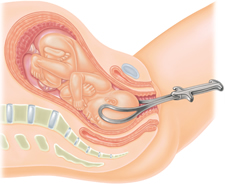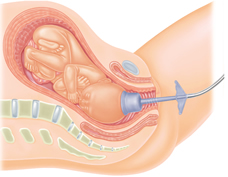Assisted Birth

In this article, you will find:
Vacuum extractor
The vacuum, or vacuum extractor, was invented in the 1950s. It consists of a cup attached to a tube that connects to a suction pump. The cup, which can be hard or soft plastic or metal, is placed on top of the baby's head and held in place while the suction creates a vacuum that makes the cup adhere to the baby's scalp. The doctor pulls downward while you push during a contraction.
Vacuum births are known to be very safe as long as you are at least 34 weeks pregnant. Before this time your baby's head may be too fragile to deal with the suction and few doctors use a vacuum before 32 weeks.
Pros and cons of vacuum
The vacuum has some advantages over forceps; it is often a little easier to apply and may be less uncomfortable for you. It is also less likely to cause vaginal and perineal damage and you will be less likely to need an episiotomy. However, vacuum fails in up to 20 percent of cases, and it is especially likely to fail if your baby is not in the ideal position for the birth. Some doctors think it is also more likely to fail if your contractions are weak, if there is already a lot of natural swelling on your baby's head, or if you are too tired to push. If a vacuum does come off during the birth, it can be reapplied, or the doctor can reach for a pair of forceps instead. Sometimes, however, a cesarean section has to be performed if the vacuum fails.
It can be painful having an assisted vaginal birth, so it is important that you have sufficient pain relief to help you cope with the delivery. In some situations, an injection of a local anesthetic in and around the vagina is sufficient to help you deal with the pain, particularly if the doctor is anticipating the birth to be fairly quick, and if your baby has already traveled most of the way through your pelvis. For more difficult assisted births, for example where the baby is not in an occiput anterior position (see Posterior presentation), an epidural may be given (see Epidurals). This is especially useful if you're going to give birth in the operating room instead of the delivery room because forceps or vacuum have a high chance of failing, leading to the need for a cesarean. Finally, if you already have an epidural in place, this can be topped up with additional medication if necessary.
Assisting your baby's birth with vacuum or forceps is a safe, well practiced procedure, which can prevent the need for an emergency cesarean. Whether you have forceps or vacuum may depend on the particular expertise and experience of the doctor doing the procedure.

With forceps, your baby's head is cradled on either side with metal tongs that guide him down in time with your contractions.

With vacuum, a soft suction cup is attached to your baby's head and then your baby is gently guided out.